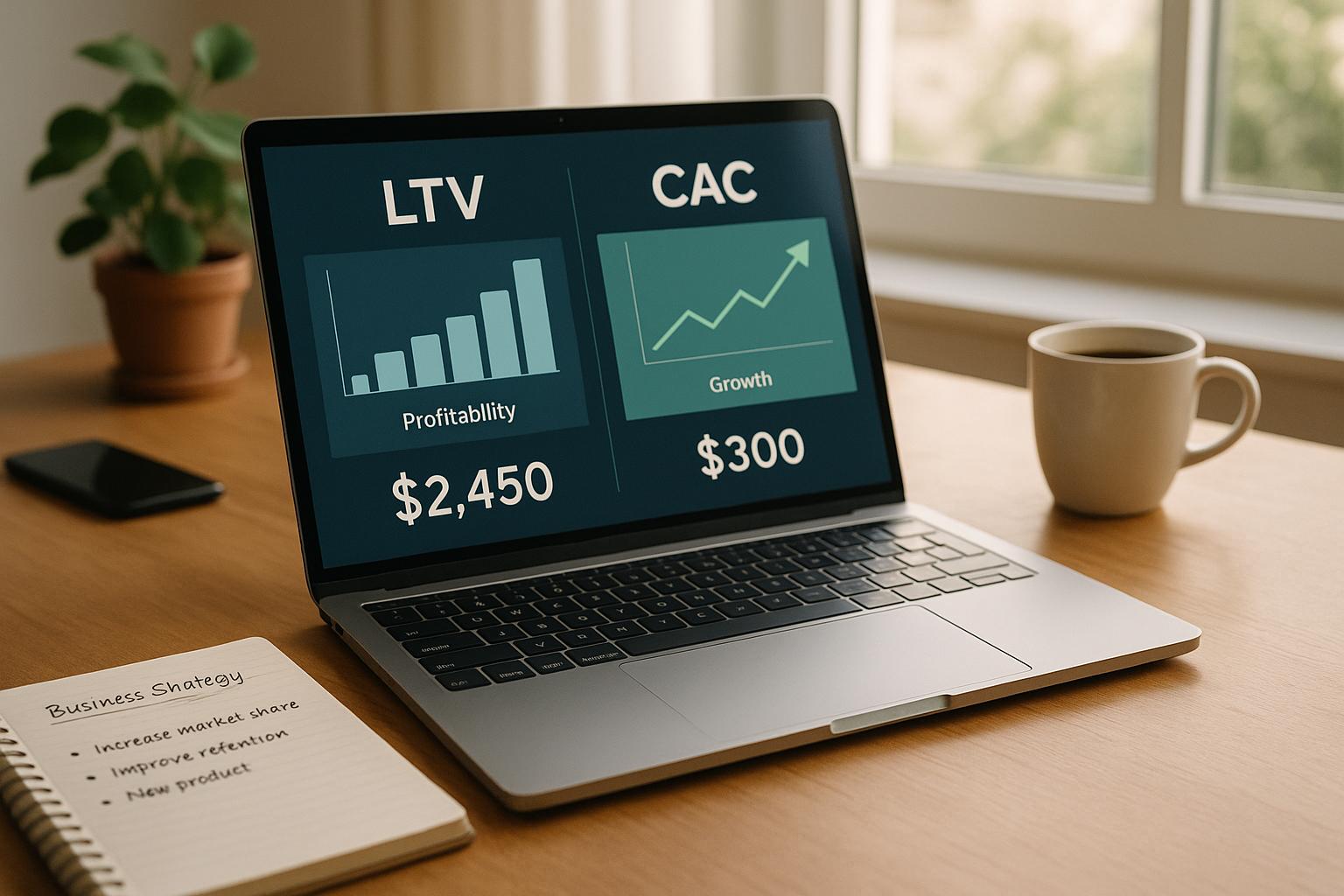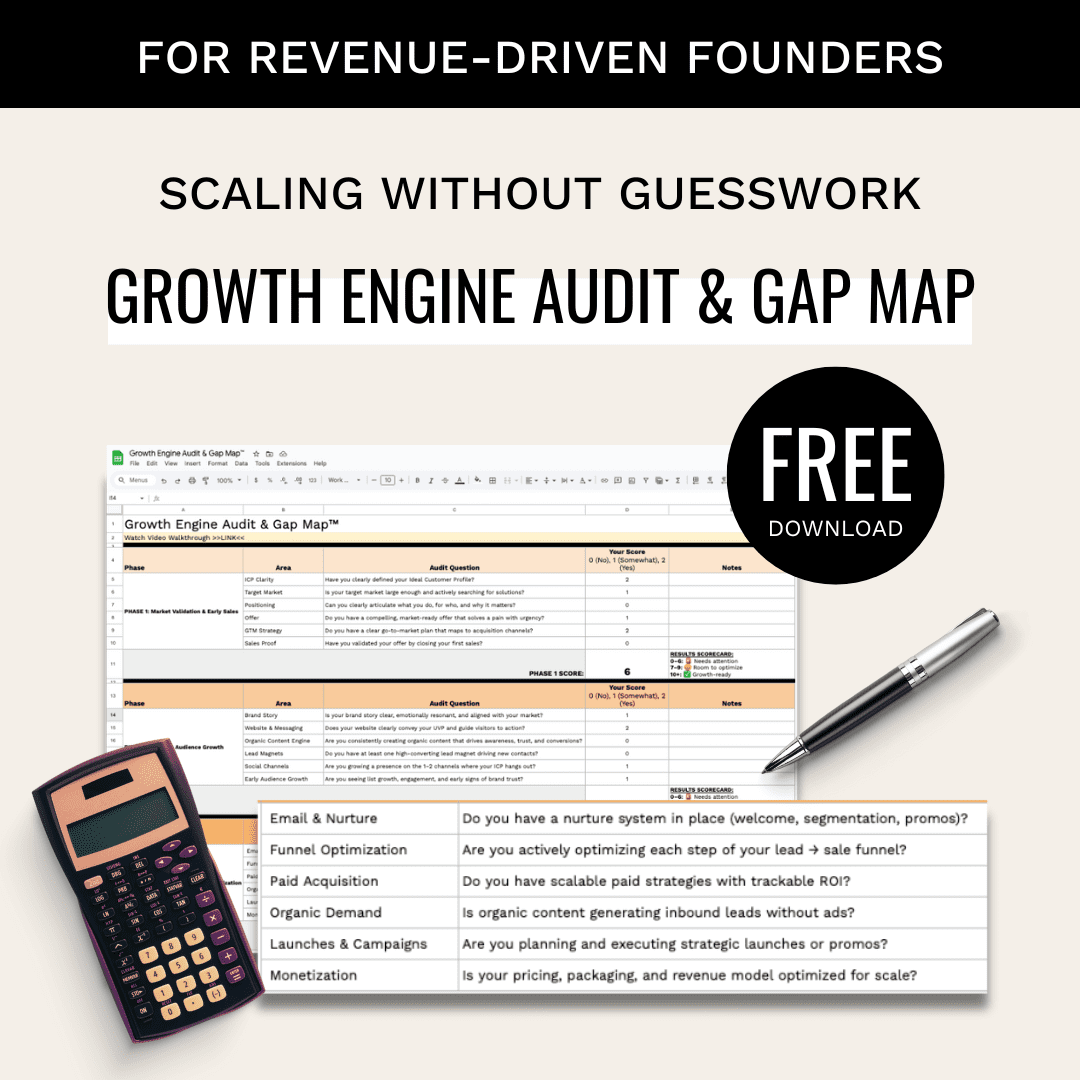Want to measure your business’s profitability? Start with LTV and CAC.
- LTV (Lifetime Value): The total revenue a customer generates during their relationship with your business.
- CAC (Customer Acquisition Cost): The cost of acquiring a new customer, including marketing and sales expenses.
- Why it matters: A healthy LTV:CAC ratio (ideally 3:1) means you’re generating 3x the revenue for every dollar spent on customer acquisition.
Quick Overview:
- LTV Formula (SaaS): Average MRR × (1 ÷ Monthly Churn Rate) × Gross Margin.
- CAC Formula: Total Marketing & Sales Expenses ÷ New Customers Acquired.
- Target Ratio:
- < 1:1: Losing money – fix immediately.
- 3:1: Healthy growth.
- > 5:1: Potential underinvestment in marketing.
These metrics help you decide where to invest, improve customer retention, and reduce acquisition costs for sustainable growth. Let’s break it down further.
How to Calculate CAC & LTV | The 2 Key Metrics for Growth
LTV and CAC Calculation Methods
Now that we’ve covered the basics, let’s dive into how to calculate LTV (Lifetime Value) and CAC (Customer Acquisition Cost) for different business models.
Computing LTV
The method for calculating LTV depends on your business type.
For SaaS companies:
The formula is:
LTV = Average MRR per account × (1 ÷ monthly churn rate) × gross margin
Here’s an example:
- Average Monthly Recurring Revenue (MRR) per account: $500
- Monthly churn rate: 2%
- Gross margin: 75%
Plugging in the numbers:
$500 × (1 ÷ 0.02) × 0.75 = $18,750 per customer.
For e-commerce businesses:
The formula changes slightly:
LTV = Average Order Value × Number of Repeat Sales × Average Retention Time × Gross Margin
Computing CAC
The formula for CAC is straightforward:
CAC = Total Sales and Marketing Expenses ÷ Number of New Customers
To calculate CAC accurately, it’s essential to track all acquisition-related costs. These typically fall into the following categories:
| Cost Category | Components |
|---|---|
| Marketing Costs | Ad spend, content creation, tools/software |
| Sales Costs | Sales team salaries, commissions, bonuses |
| Overhead | Marketing technology, sales enablement tools |
| Support Costs | Onboarding resources, sales support staff |
Key Metrics Comparison
By calculating LTV and CAC, you gain a clearer picture of your business’s financial health. Here’s how these metrics compare:
| Metric | Data Requirements | Measurement Period | Key Considerations |
|---|---|---|---|
| LTV | Revenue data, churn rate, margins | 12+ months | Historical data is crucial for accurate results. |
| CAC | Marketing and sales expenses | 3–6 months | Typically assessed over shorter timeframes. |
A real-world example highlights the importance of these metrics. Casper Sleep‘s February 2020 data showed that only 16% of its customers made repeat purchases. Coupled with high social media acquisition costs, this led to a sharp valuation drop – from $1.1 billion in March 2019 to $575 million by February 2020.
For a more accurate view of customer profitability, consider using contribution margin instead of gross margin when calculating LTV. This approach, recommended by Andreessen Horowitz, provides a more realistic estimate.
Understanding the LTV:CAC Ratio
The LTV:CAC ratio measures how effectively a business turns customer acquisition costs into long-term revenue. It compares the lifetime value of a customer (LTV) to the cost of acquiring that customer (CAC). Let’s break this down further by exploring target ratios, analysis, and actionable insights.
Target Ratio: 3:1
A well-balanced LTV:CAC ratio is typically 3:1, meaning every customer should generate three times the cost it took to acquire them.
| Ratio Range | Business Health Indicator | Suggested Action |
|---|---|---|
| < 1:1 | Critical | Losing money on every customer – take immediate corrective steps |
| 1:1 – 2:1 | Poor | Unsustainable after factoring in operating costs – adjust strategy |
| 3:1 – 4:1 | Healthy | Ideal for steady, sustainable growth |
| > 5:1 | Potential Underinvestment | Likely underinvesting in marketing – consider increasing spend |
Ratio Analysis Guide
The LTV:CAC ratio provides a snapshot of how efficiently you’re acquiring customers. For instance, if your LTV is $1,000 and your CAC is $500, you have a 2:1 ratio. This suggests room for improvement – either by lowering acquisition costs or increasing the value each customer brings.
"Most experts…agree that 3:1 is a good LTV to CAC ratio. You can interpret it as your business makes 3x of what it costs to acquire a customer, or for every $1 spent on acquisition, you get $3 back."
- Sergey Pirogov, founder and CEO of molfar.io
Using Ratios for Decisions
Your LTV:CAC ratio isn’t just a number – it’s a tool to guide your next steps. Here’s how to act based on your ratio:
If Your Ratio Is Below 3:1:
- Focus on content marketing and email campaigns to engage customers at a lower cost.
- Conduct user research to improve conversion rates and refine your sales funnel.
- Streamline the sales cycle to reduce friction in the buying process.
- Adjust pricing strategies to boost average revenue per user (ARPU).
If Your Ratio Exceeds 5:1:
- Explore new customer acquisition channels to scale your reach.
- Increase your marketing budget to capture untapped opportunities.
- Invest in expansion projects or explore new markets.
- Test different customer segments to diversify your audience.
Keep in mind, industry benchmarks vary. While SaaS companies often aim for a 3:1 ratio, e-commerce businesses might settle for a 2:1 ratio due to slimmer margins and shorter customer lifecycles. Context is key when interpreting these numbers.
Improving LTV and CAC Results
Once you’ve got a handle on calculating LTV (Lifetime Value) and CAC (Customer Acquisition Cost), the next step is optimizing these metrics. In 2023, 67.7% of companies planned to increase their investment in customer retention. Why? Because improving LTV while lowering CAC is essential for sustainable growth.
Strategies to Boost LTV
Increasing customer lifetime value hinges on keeping customers engaged and loyal over time.
Enhancing the Customer Experience:
- Offer personalized support systems – these have been shown to double retention rates.
- Use targeted product recommendations based on purchase history to drive repeat purchases.
- Build omnichannel engagement strategies to connect with customers wherever they are.
A great example is Native, a beauty brand that tapped into micro-influencers to create relatable, authentic content. This approach not only boosted customer engagement but also reduced marketing expenses.
Reducing CAC
Lowering customer acquisition costs is all about being strategic with your marketing channels and resources. Here are some effective methods:
| Strategy | Impact | Implementation |
|---|---|---|
| Retargeting | Up to 1,046% increase in trademark searches within 4 weeks | Focus on abandoned cart and browse recovery campaigns. |
| Content Marketing | Drives organic growth | Invest in SEO-optimized content creation. |
| Referral Programs | 80% positive ROI from loyalty initiatives | Launch customer advocacy programs. |
Take Bumble, for example. The dating app studied Gen Z preferences and created relatable TikTok campaigns. Their viral first-date experience campaign not only reduced CAC but also drove a surge in signups.
Keep an Eye on Performance
Once you’ve fine-tuned your acquisition and retention strategies, tracking performance is key to ensuring they deliver results. Arena Solutions is a great case study – they narrowed their target segments from 40 to 12, which significantly accelerated their growth.
Here are some ways to monitor performance:
- Analyze cohort performance across different marketing channels.
- Gather customer feedback through surveys to spot areas for improvement.
- Use A/B testing to refine marketing messages and pricing strategies.
- Track sales pipeline velocity to optimize conversions.
For tech companies, a Fractional CMO can be a game-changer. They bring advanced tracking and analysis expertise to the table. At Data-Mania, we offer tailored Fractional CMO services to help tech businesses craft data-driven strategies that align marketing efforts with overall goals.
sbb-itb-e8c8399
Putting LTV and CAC to Work
Tracking performance is just the beginning. With the right CRM and analytics tools, you can turn raw data into meaningful insights that drive smarter decisions.
CRM and Analytics Setup
HubSpot Implementation:
- Configure custom properties to monitor acquisition costs by channel.
- Create smart lists to segment customers effectively.
- Set up lifecycle stage tracking to understand customer journeys.
- Use revenue attribution reporting to connect marketing efforts to revenue outcomes.
Salesforce Integration:
- Add custom fields to track both costs and revenue.
- Build automated dashboards to monitor your LTV:CAC ratio in real time.
- Leverage predictive analytics to estimate customer lifetime value and guide future strategies.
Modern CRMs provide precise tools for measuring and improving your LTV:CAC ratio. These integrations serve as the foundation for making data-driven adjustments under skilled marketing leadership.
Fractional CMO Support
Once your analytics and CRM systems are in place, an experienced Fractional CMO can take your strategy to the next level. By partnering with an expert, tech companies can fine-tune their LTV:CAC ratio and unlock more value from their data. At Data-Mania, we specialize in helping tech companies implement strategies that balance acquisition costs with long-term customer value.
Here’s where a Fractional CMO can make an impact:
- Channel optimization: Identify and scale the most cost-effective acquisition channels using performance data.
- Customer segmentation: Focus on high-value customer profiles with tailored marketing approaches.
- Retention programs: Design engagement strategies that encourage repeat purchases and boost loyalty.
SaaS Company Example
Let’s look at a real-world success story. A B2B SaaS platform was struggling with an LTV of $3,600 and a CAC of $2,000, resulting in a 1.8:1 ratio. By implementing data-driven strategies – like targeted customer segmentation, tiered pricing models, and refining acquisition channels – they achieved remarkable results. Their LTV jumped to $5,670, while CAC dropped to $1,800, pushing their ratio to a healthy 3.15:1.
This shift not only exceeded the 3:1 benchmark investors often look for but also set the company on a path for sustainable growth. It’s a clear example of how strategic adjustments backed by data can transform business outcomes.
Conclusion: Keys to LTV and CAC Success
Here’s the bottom line: Companies with an LTV:CAC ratio of 3:1 or higher tend to perform better in the market and gain stronger investor trust.
These metrics are more than just numbers – they guide smarter marketing strategies. If your LTV:CAC ratio falls below the 3:1 benchmark, it’s a clear signal to either increase the value you’re getting from customers or find ways to lower your acquisition costs.
Take this SaaS company as an example: They achieved an LTV of $600 with a CAC of $100, resulting in a stellar 6:1 ratio. This efficiency in customer acquisition, paired with strong customer value, helped them stand out and attract investor interest.
To put these principles into action, consider these steps:
- Monitor Regularly: Keep a close eye on your LTV:CAC ratio each month to spot trends and opportunities.
- Maintain Balance: Aim for the 3:1 ratio while still driving growth.
- Leverage Data: Let your metrics guide decisions about marketing budgets and channel strategies.
Achieving optimal LTV and CAC often requires skilled leadership and advanced analytics. Partnering with experienced marketing professionals – like the Fractional CMO services offered by Data-Mania – can provide the expertise you need to navigate the challenges of balancing profitability with growth. With thoughtful planning and ongoing optimization, businesses can create a reliable system for growth that consistently delivers returns on marketing investments.
FAQs
What can a business do to improve its LTV:CAC ratio if it falls below the ideal 3:1 benchmark?
How to Improve Your LTV:CAC Ratio
If your LTV:CAC ratio is falling short of the recommended 3:1 benchmark, there are two main levers to pull: increasing customer lifetime value (LTV) and cutting down customer acquisition cost (CAC).
To boost LTV, focus on strategies that deepen customer loyalty and encourage repeat business. This might include improving retention efforts, introducing upsell or cross-sell opportunities, and enhancing the quality of your product or service to keep customers coming back. The goal is to make every customer relationship more valuable over time.
On the flip side, reducing CAC requires a sharper approach to acquiring customers. You can do this by fine-tuning your marketing campaigns to make them more efficient, narrowing your targeting to attract higher-value customers, and streamlining your sales processes to lower the overall cost of bringing in new business.
For tech companies, tapping into Fractional CMO services can be a game-changer. These experts offer tailored strategies to align your marketing efforts with your goals, helping you maximize ROI while keeping acquisition costs in check.
What are the best ways to lower Customer Acquisition Cost (CAC) while maintaining high-quality customers?
Reducing Customer Acquisition Cost (CAC) while maintaining customer quality calls for a smart, focused strategy. Start by zeroing in on your ideal audience. By narrowing your focus to the most relevant and high-value prospects, you can ensure your marketing efforts are directed at people who are more likely to convert and remain loyal over time.
Next, take a close look at your marketing channels. Identify which platforms deliver the best return on investment and shift your budget to prioritize those. At the same time, don’t forget about your current customers – referral programs and loyalty incentives are powerful ways to encourage word-of-mouth marketing. These strategies not only lower CAC but also bring in leads who are often more engaged and ready to buy.
Lastly, make use of data to fine-tune your approach. Tools like predictive analytics can uncover trends and patterns, helping you make smarter decisions and cut unnecessary spending. By focusing on these tactics, you can grow efficiently while keeping your acquisition costs under control.
How does the ideal LTV:CAC ratio vary between industries like SaaS and e-commerce?
The LTV:CAC ratio – the comparison of a customer’s lifetime value to the cost of acquiring them – varies widely across industries. This is largely due to differences in business models, acquisition costs, and how long customers typically stick around.
Take SaaS companies, for instance. They usually aim for a ratio of 3:1, meaning the revenue a customer generates over their lifetime should be three times what it costs to bring them on board. This makes sense since SaaS businesses thrive on recurring revenue and long-term customer loyalty.
In contrast, e-commerce businesses often deal with slimmer profit margins and higher customer turnover. As a result, their target ratio might hover closer to 2:1. These variations underscore why it’s crucial to align your LTV:CAC benchmarks with your specific industry and goals. By doing so, you can fine-tune your marketing efforts, improve ROI, and set the stage for steady growth.
Related Blog Posts
- How to Build a SaaS Marketing Strategy from Scratch
- Cost-to-Revenue Ratio: How to Calculate
- Ultimate Guide to Marketing Channel Benchmarking
- Ultimate Guide To Partnership ROI Metrics




